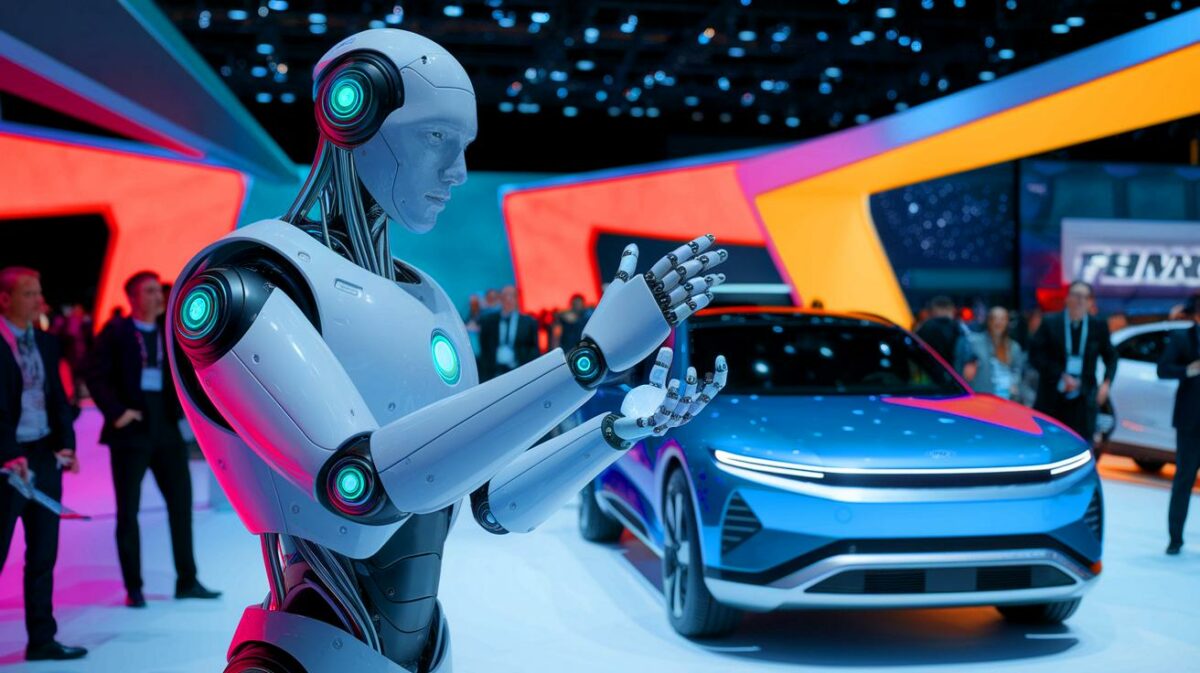| IN A NUTSHELL |
|
In a world where technology is evolving at an unprecedented pace, the intersection of robotics and automotive innovation is creating a new frontier. Chinese firm XPENG has unveiled its first humanoid robot, Iron, at Auto Shanghai 2025, captivating audiences with its human-like abilities and advanced AI technology. Iron is not just a robotic marvel; it represents a significant step forward in bridging the gap between self-driving electric vehicles and humanoid robotics. This integration promises to redefine how we perceive and interact with technology in our daily lives.
Breaking Ground with Humanoid Robotics
The debut of XPENG’s humanoid robot, Iron, at the Auto Shanghai 2025, marks a milestone in the field of robotics. Iron’s ability to fist-bump and wave at attendees showcases its human-like dexterity and interaction capabilities. With 22 degrees of freedom in its hands, Iron can perform precise object handling tasks, which are essential for practical applications in various settings. Its movements are powered by advanced models and reinforcement learning techniques, which allow for smooth and natural gestures. This development signifies a leap forward from the traditional, rigid movements seen in earlier robots.
Iron is equipped with XPENG’s cockpit AI, enabling it to engage in natural conversations. This AI system is shared with XPENG’s self-driving electric vehicles, demonstrating a unique integration of automotive and robotics technology. By leveraging this shared AI ecosystem, Iron can communicate effectively using reasoning and logic, making it an intelligent companion in both private and public spaces. The robot’s design, standing at 5’8″ and weighing 154 pounds, mirrors human proportions, further enhancing its human-like presence.
Advanced AI and Processing Power
At the heart of Iron’s capabilities lies XPENG’s Turing AI chip, which delivers a staggering 3,000 trillion operations per second (TOPS) of processing power. This high processing capability allows Iron to perform complex calculations and execute tasks with precision and speed. The robot’s architecture includes 60 joints and 200 degrees of freedom, enabling a wide range of motion that mimics human flexibility. Such advanced engineering allows Iron to move with unparalleled fluidity, setting a new standard for humanoid robots.
The integration of XPENG’s AI Tech Tree strategy is central to Iron’s development. This strategy combines AI, energy solutions, and embodied intelligence to create a holistic ecosystem of intelligent technologies. By incorporating these elements, XPENG aims to advance not only humanoid robotics but also intelligent electric vehicles and even flying vehicles. This comprehensive approach underscores XPENG’s commitment to pushing the boundaries of technological innovation.
Implications for the Future
As XPENG continues to expand its technological capabilities beyond automotive applications, the implications for the future are profound. Iron’s presence at Auto Shanghai 2025 signals a new era of intelligent machines that can seamlessly integrate into our daily lives. By bridging the fields of robotics and automotive technology, XPENG is paving the way for a future where robots and humans coexist in harmony, enhancing our capabilities and improving our quality of life.
The potential applications of humanoid robots like Iron are vast, ranging from personal assistants to industrial automation. As these robots become more advanced and widely adopted, they have the potential to revolutionize industries and transform everyday tasks. XPENG’s vision of a future ecosystem that includes intelligent EVs, humanoid robots, and flying vehicles offers a glimpse into a world where technology enhances every aspect of our lives.
Challenges and Opportunities Ahead
Despite the impressive capabilities of XPENG’s Iron, several challenges remain on the path to widespread adoption of humanoid robots. One of the main challenges is ensuring the safety and reliability of these machines in various environments. As robots like Iron become more integrated into society, it is crucial to develop robust systems that prevent accidents and ensure user safety.
Additionally, the ethical considerations of deploying humanoid robots in public and private spaces must be addressed. Issues such as privacy, data security, and the potential displacement of human workers need careful consideration. However, these challenges also present opportunities for innovation and collaboration across industries. As companies like XPENG continue to push the envelope, they can inspire new solutions and drive progress in the field of robotics.
As XPENG’s humanoid robot, Iron, makes waves at Auto Shanghai 2025, it leaves us pondering the future of robotics and human interaction. Will these intelligent machines become commonplace in our homes and workplaces, transforming our daily lives? The possibilities are endless, and the journey is just beginning.
Did you like it? 4.6/5 (22)










Wow, a robot that can fist-bump! What’s next, a robot that can do the moonwalk? 😂
Is this just a stunt for the expo, or does XPENG plan to release these robots to the public soon?
Finally, a robot that can keep up with my dance moves! 💃
I’m curious about the ethical implications of humanoid robots. How do they ensure user privacy and data security?
Why does every futuristic robot seem to promise flying cars? 😅
22 degrees of freedom in its hands? That’s more freedom than I’ve got on weekends!
Thanks for the insightful article! It’s amazing to see how far robotics has come.
How does Iron compare to similar robots from companies like Boston Dynamics?
I hope this doesn’t mean we’re getting closer to a robot uprising. 😬
XPENG’s vision sounds ambitious, but what are the real-world applications for Iron?
Do you think humanoid robots will become a common sight in public spaces soon?
Iron’s AI seems advanced, but how does it handle unexpected situations?
Is this robot available for purchase or just a concept at the moment?
The integration of AI in both cars and robots is fascinating. What’s next, AI in toasters? 🍞
How does XPENG ensure the safety of these robots in public areas?
Iron weighs 154 pounds? That’s one heavy dance partner! 😂
This is a game-changer for the automotive industry! Thanks for sharing. 🚗🤖
Does Iron have any features that set it apart from other humanoid robots?
The future is here, and it’s fist-bumping us! 🤖👊
I’m skeptical about the practical uses of such advanced robots. Any thoughts?
How long before Iron can do more complex tasks, like cooking dinner? 🍽️
Is there any information on the cost of developing such a robot?
XPENG’s AI Tech Tree strategy sounds impressive. Is it exclusive to their robots?
Can’t wait to see these robots in action at the next tech expo! 🙌
What kind of maintenance does a humanoid robot like Iron require?
Does Iron’s AI allow it to learn new tasks over time?
How does Iron’s processing power compare to other robots on the market?
Will Iron be able to integrate with smart home systems in the future? 🏠
This is exciting, but I’m worried about job displacement. What do you think?
Can Iron be customized for specific industries, like healthcare or education?
With 60 joints, Iron must be quite flexible! Can it do yoga too? 🧘♂️
Is there any video footage of Iron at the expo? Would love to see it in action!
How does XPENG plan to address the ethical challenges of humanoid robots?
I’m amazed by the possibilities, but how far are we from having robots like Iron in homes?
What are the main challenges XPENG faces in bringing Iron to market?
Thanks for the article! It’s exciting to think about the future of robotics.